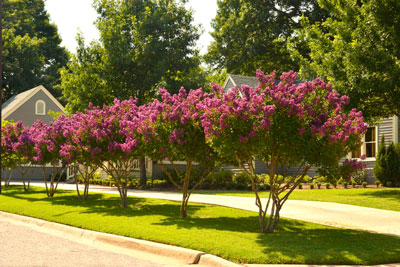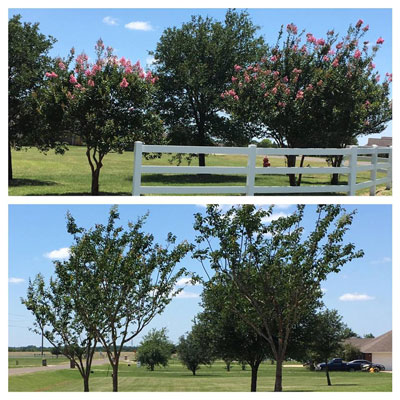Question of the Week Number 1: June 15, 2017
“Neil, why is my crape myrtle not blooming when those in neighbors’ yards are in full bloom?”
When a caller from Brownwood asked this on my statewide radio program last Saturday, my board operator asked off-air five minutes later, “Neil, I didn’t hear what you told him. Could you repeat it?” And so, that’s how my week has gone since.

Photo: Catawba crape myrtles have long been my favorite color. Here is their first round of four blooms in a McKinney landscape a couple of years ago.
Crape myrtles need sun, moisture, nitrogen and new growth to produce their blooms. When you have a plant that lags behind the neighbors’ plants in its first blooms, there are three possible causes (and maybe more).
What slows down crape myrtles’ blooms…
1. Perhaps you topped it. Nothing slows a crape myrtle down any more in producing its first round of flowers. It can be by as much as six or eight weeks. There’s no reason to top a crape myrtle anyway (since it ruins their shape), and when you figure it reduces their overall floral output and delays their blooms, that’s a habit that’s easy to break.

Photo: A Facebook friend from the Bryan/College Station area posted this comparison of unpruned versus topped crape myrtles last weekend to show how much earlier the unpruned ones had their first round of blooms.
2. Maybe it’s in too much shade. Crape myrtles need full sun. They can tolerate a couple of hours of shade. After that, however, production of flowers starts to plummet as you stir more and more shade into their lives. And they’ll be much later to bloom.
3. Third, and most elusive: it could be the variety. There are more than 125 varieties of crape myrtles in the nursery industry today. Some of them regularly produce their first round of blooms in late April or early May. Others such as the old popular type named County Red don’t bloom until mid- to late July.
You need to know what variety you have and then you can determine if its late blooming habits are all in its genes. Think back to its historic performance. How has it been over the past 10 years? If it’s always been the last plant on the block to come into flower, this may be the cause.
What do you do?
What’s your best course of action? Take the best possible care of your plant. Sit back and relax. It will eventually bloom!
